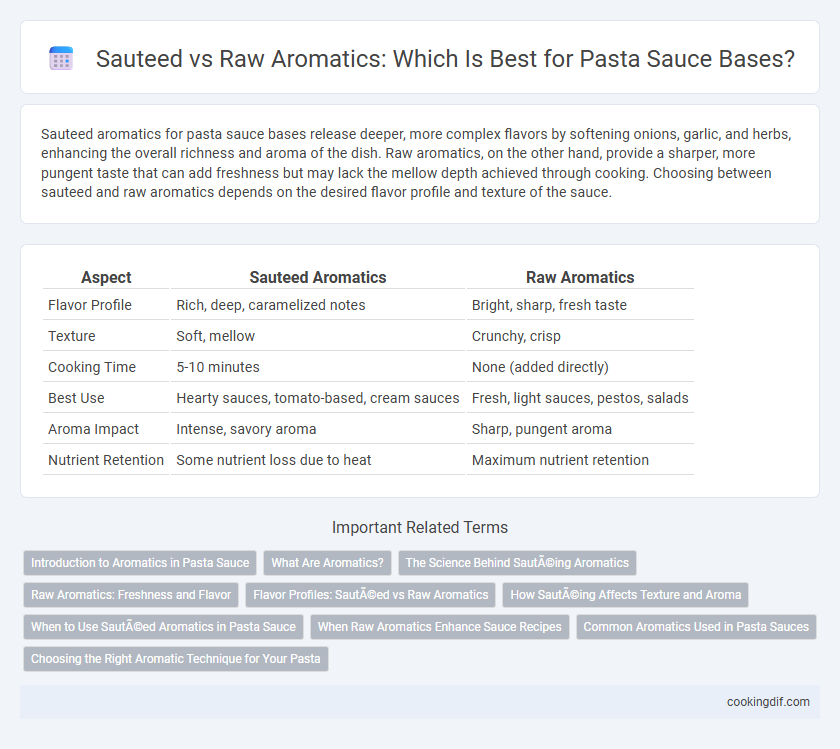Sauteed aromatics for pasta sauce bases release deeper, more complex flavors by softening onions, garlic, and herbs, enhancing the overall richness and aroma of the dish. Raw aromatics, on the other hand, provide a sharper, more pungent taste that can add freshness but may lack the mellow depth achieved through cooking. Choosing between sauteed and raw aromatics depends on the desired flavor profile and texture of the sauce.
Table of Comparison
| Aspect | Sauteed Aromatics | Raw Aromatics |
|---|---|---|
| Flavor Profile | Rich, deep, caramelized notes | Bright, sharp, fresh taste |
| Texture | Soft, mellow | Crunchy, crisp |
| Cooking Time | 5-10 minutes | None (added directly) |
| Best Use | Hearty sauces, tomato-based, cream sauces | Fresh, light sauces, pestos, salads |
| Aroma Impact | Intense, savory aroma | Sharp, pungent aroma |
| Nutrient Retention | Some nutrient loss due to heat | Maximum nutrient retention |
Introduction to Aromatics in Pasta Sauce
Sauteed aromatics such as garlic, onions, and shallots release rich, mellow flavors that form a savory backbone in pasta sauces. Raw aromatics provide a sharper, more pungent taste that can brighten fresh tomato or herb-based sauces. Choosing between sauteed or raw aromatics influences the sauce's depth, balancing complexity with freshness in classic Italian pasta dishes.
What Are Aromatics?
Aromatics are flavorful ingredients like onions, garlic, celery, and carrots used to enhance pasta sauce bases. Sauteed aromatics develop deeper, richer flavors through caramelization, while raw aromatics provide a fresher, sharper taste. Choosing between sauteed and raw aromatics significantly affects the sauce's overall aroma and complexity.
The Science Behind Sautéing Aromatics
Sauteing aromatics such as onions, garlic, and herbs transforms their cellular structure, releasing essential oils and enhancing flavor complexity through the Maillard reaction, which creates rich, savory notes ideal for pasta sauces. Raw aromatics provide a sharper, more pungent taste but lack the depth and sweetness developed by heating. Understanding this process allows chefs to balance flavor intensity and aroma, optimizing the sauce base for a more satisfying pasta dish.
Raw Aromatics: Freshness and Flavor
Raw aromatics, such as finely chopped garlic, onions, and herbs, infuse pasta sauces with a vibrant freshness and pronounced flavor that sauteed versions may lack. Their uncooked state preserves essential oils and volatile compounds, delivering a bright, sharp taste that enhances the overall dish complexity. Incorporating raw aromatics directly into sauce bases ensures a lively, aromatic profile that complements the pasta's texture and ingredient harmony.
Flavor Profiles: Sautéed vs Raw Aromatics
Sauteed aromatics develop deeper, richer flavor profiles by caramelizing natural sugars and softening sharp edges, enhancing sauces with a warm, savory base ideal for tomato or cream pasta sauces. Raw aromatics offer brighter, more pungent notes that preserve freshness and a sharp bite, often used to create vibrant, uncooked sauces like pesto or salsa verde. Choosing between sauteed or raw aromatics directly impacts the sauce's depth, complexity, and overall flavor balance in pasta dishes.
How Sautéing Affects Texture and Aroma
Sauteing aromatics for pasta sauce enhances the texture by softening onions, garlic, and herbs, creating a smoother base that blends seamlessly into the sauce. This process releases essential oils and intensifies aromas through caramelization and Maillard reactions, deepening the flavor profile. Raw aromatics provide a sharper, more pungent taste, but lack the complexity and mellow richness sauteed ingredients develop.
When to Use Sautéed Aromatics in Pasta Sauce
Sauteed aromatics are ideal for pasta sauces when a rich, deep flavor base is desired, as the caramelization process enhances sweetness and complexity. Use sauteed onions, garlic, and herbs early in the cooking process to build layers of flavor, especially in tomato-based or meat sauces like Bolognese. This technique is essential for sauces that require longer cooking times, allowing the aromatics to fully infuse their essence into the sauce.
When Raw Aromatics Enhance Sauce Recipes
Raw aromatics enhance sauce recipes by preserving the fresh, vibrant flavors of ingredients like garlic, onions, and herbs, which can sometimes be muted when sauteed. Incorporating raw aromatics is especially beneficial in light, oil-based sauces or fresh pasta dressings where crispness and brightness are desired. This technique intensifies the aromatic profile and balances richness without the caramelized sweetness that sauteing introduces.
Common Aromatics Used in Pasta Sauces
In pasta sauces, common aromatics like garlic, onions, and shallots provide foundational flavors, with sauteed aromatics enhancing sweetness and depth through caramelization while raw versions deliver a sharper, more pungent bite. Herbs such as basil, oregano, and parsley are typically added raw or towards the end of cooking to preserve their bright, fresh flavors and essential oils. Choosing sauteed versus raw aromatics directly impacts the sauce's complexity, texture, and overall flavor profile, making it crucial to balance cooking techniques based on the desired taste.
Choosing the Right Aromatic Technique for Your Pasta
Sauteed aromatics, like garlic and onions cooked in olive oil, develop deeper flavors and a caramelized sweetness that enhance pasta sauce richness. Raw aromatics offer a fresher, sharper taste ideal for light, uncooked pasta sauces such as pesto or salsa verde. Choosing the right technique depends on the desired sauce profile, with sauteed aromatics suited for hearty tomato or cream-based sauces and raw aromatics complementing vibrant, herb-forward recipes.
Sautéed vs raw aromatics for sauce bases Infographic

 cookingdif.com
cookingdif.com